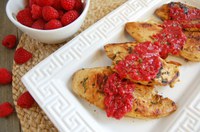Prairie Fare: Protect Your Skin When Playing in the Sun
(Click an image below to view a high-resolution image that can be downloaded)
By Julie Garden-Robinson, Food and Nutrition Specialist NDSU Extension
Several years ago, I had a couple of program assistants who loved to enter radio contests. One day they walked into my office to discuss the day’s activities.
I was a little surprised when I looked up, but I think I maintained a poker face.
“How are you doing today?” I asked.
“Well, we won free spray tans,” one of them said sheepishly.
Her fair skin was almost as orange as a bottle of Tide detergent. She looked embarrassed.
“Don’t worry. It will wear off in a few days,” I said.
Fortunately, spray tans and sunless tanning lotions are not hazardous to your health. Dihydroxyacetone (DHA) is the active ingredient in most sunless tanning lotions. Fortunately, the products have improved through the years.
I was glad my program assistants hadn’t won a bunch of tanning bed sessions. According to the Food and Drug Administration (FDA), tanning beds can increase your risk of skin cancer, including melanoma. Tanning beds also can cause eye damage.
Further, the FDA reported that about 3,000 emergency room visits occur annually because of injuries associated with tanning beds.
We have reached the time of year when shorts and tank tops appear, and many fair-skinned people want to have a “healthy tan.” Unfortunately, being tan indicates that your skin has produced melanin to shield against sun damage. We are entering the season when we spend more time outdoors and expose more skin for longer amounts of time, which can lead to damage and increase our risk for skin cancer.
More people get a skin cancer diagnosis than all of the other types of cancer combined, according to the Skin Cancer Foundation.
Skin cancer is the uncontrolled growth of skin cells due to DNA damage. Melanoma is the most deadly form of skin cancer, while basal cell and squamous cell carcinoma are more common and highly curable.
Think about your own skin. Do you have any spots on your skin that:
- have changed in color, size or texture
- are bigger than 1/4 inch (the diameter of a pencil eraser)
- appeared after age 21
- appear pearly, translucent, tan, brown, black or multicolored
- itch, hurt, crust over or scab, erode, bleed or haven’t healed within 3 weeks?
Be sure to let your healthcare provider know about any suspicious spots so you can get the proper follow-up, if needed, with a specialist.
If you have had a sunburn, you are at risk for skin cancer. If you have used a tanning bed, you also are at greater risk for skin cancer.
Remember, too, that 90% of skin aging is caused by sun exposure, according to an article in a dermatology scientific journal.
Fortunately, we all have some steps that we can take to reduce our risk for skin cancer, which also will protect our skin from aging.
- Be sure to wear sunscreen. Most sources recommend a sunscreen with a sun protection factor (SPF) of 30 or higher.
- Apply plenty of sunscreen. One ounce is the typical recommendation. Be sure to reapply sunscreen every two hours or more often if you are swimming or perspiring.
- Look for an expiration date on sunscreen. If it does not have a date listed on the bottle, label the bottle with the date of purchase and use within three years.
- Seek shade during the hours from 10 a.m. to 4 p.m.
- If you need to be outside, experts recommend wearing long-sleeved clothes and pants made with tightly woven fabric.
- Don’t forget to protect your eyes. Wear high-quality sunglasses that protect your eyes from ultraviolet (UV)-A and UV-B rays. Sun exposure can increase the risk of both macular degeneration and cataracts.
Visit https://www.ag.ndsu.edu/nourishyourbody for more information about nourishing and protecting your skin. The site includes links to interactive games and apps.
Keep your skin nourished by eating a variety of healthful foods, especially plenty of colorful fruits and vegetables.
Grilling season has arrived, so here’s a tasty recipe that makes use of fresh or frozen raspberries.
Grilled Chicken with Raspberry Glaze
4 boneless, skinless chicken tenderloins (about 1 pound)
Marinade: 1 garlic clove, minced 1/4 c. fresh cilantro, finely chopped 1/4 c. fresh basil, finely chopped 1 Tbsp. fresh lime juice 2 Tbsp. canola oil (or your favorite oil) 1/4 tsp. ground pepper 1 Tbsp. low-sodium soy sauce 1 Tbsp. oyster sauce
Raspberry Glaze: 1 c. raspberries, divided 2 Tbsp. rice wine vinegar 1/2 tsp. honey 2 Tbsp. red onion, finely chopped 1 tsp. serrano pepper, minced
Place chicken into a zip-top bag or a resealable container. Combine all the ingredients for the marinade in a large bowl, add to chicken and refrigerate for about one hour. Before cooking the chicken, assemble the spicy raspberry glaze by combining half of the raspberries (1/2 cup), vinegar and honey in a small pan. Bring the mixture to a boil, then let simmer for 10 minutes. While the glaze is simmering, use a utensil to crush the raspberries so the glaze has no visible lumps. Let the glaze cool; meanwhile, chop the remaining raspberries, red onion and serrano pepper. Add these ingredients to the glaze and mix. Grill the chicken to an internal temperature of 165 F, then top with glaze. Serve on a bed of mixed greens if desired. Makes four servings. Each serving has 210 calories, 8 grams (g) fat, 27 g protein, 7 g carbohydrate, 0 g fiber and 340 milligrams sodium.
(Julie Garden-Robinson, Ph.D., R.D., L.R.D., is a North Dakota State University Extension food and nutrition specialist and professor in the Department of Health, Nutrition and Exercise Sciences. Follow her on Twitter @jgardenrobinson)
NDSU Agriculture Communication – May 9, 2019
| Source: | Julie Garden-Robinson, 701-231-7187, julie.garden-robinson@ndsu.edu |
|---|---|
| Editor: | Kelli Anderson, 701-231-6136, kelli.c.anderson@ndsu.edu |



